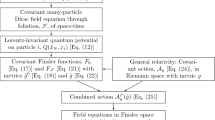Abstract
The author, who was Schrödinger's assistant during his last years in Vienna, gives an account of Schrödinger's views and activities during that time which lead him to a different approach to research on the relations between gravitation and quantum phenomena. Various features of past research are outlined in nontechnical terms. A heuristic argument is presented for the role of the zero-point energy of massive particles in counteracting gravitational collapse and the formation of horizons. Arguments are presented for the view that progress in describing extreme gravitational phenomena can be achieved by the new outlook obtained from the introduction of the analog of Maxwell's vacuum displacement term with a quasiconstant parameter, rather than from renormalization of special processes, even if this is successful. The results can be expected to be in accord with Schrödinger's conjectures.
A physical interpretation for the change of sign of the differential invariant of Karlhede, Lindström, and Åman at the horizon is suggested.
Some important historical details about Schrödinger are touched upon.
Similar content being viewed by others
References
E. Schrödinger, inLouis de Broglie, physicien et penseur (Paris, Michel 1953), pp. 16–32; reproduced inErwin Schrödinger: Collected Papers, Vol. 3, pp. 693–710, also in English.
E. Schrödinger,Nuovo Cimento 9(10), 162–170 (1958).
C. P. Johnson,Lett. Phys. Rev. 89, 320 (1953).
G. Mie,Phys. Z. 21, 651 (1920); W. Alexandrow,Ann. Phys. (Leipzig) 65(4), 675 (1921).
E. Schrödinger,Physica 6, 899–912 (1939).
L. Rosenfeld,Ann. Phys. (Leipzig) 5, 311 (1930).
E. Schrödinger,Proc. R. Irish Acad. A 46, 25–47 (1940).
Leopold Halpern,Nuovo Cimento 25, 1239 (1962).
Leopold Halpern,Ark. Fys. 34, 539–559 (1967);J. Gen. Relativ. Gravit. 3, 405–407 (1971).
E. Schrödinger,Expanding Universes (Cambridge University Press, Cambridge, 1957), Chap. 1, p. 20.
Leopold Halpern, inOndes et Radiations Gravitationelles, CNRS Paris Colloque Nr. 220, 373–378 (1973).
Leopold Halpern, Poster presented at the Schrödinger Centenary Meeting, Imperial College, London, March 1987.
Leopold Halpern,
Leopold Halpern,Ark. Fys. 35, 57–69 (1967).
B. DeWitt and R. Brehme,Ann. Phys. (New York) 9, 220–253 (1960).
L. Halpern and B. Laurent,Nuovo Cimento 33(10), 728 (1964).
S. Weinberg,Phys. Rev. 140B, 516 (1965).
Leopold Halpern and B. Jouvet,Ann. Inst. Henri Poincaré A VIII, 25 (1968).
L. Rosenfeld,Nucl. Phys. 40, 353–356 (1963).
B. DeWitt, Thesis, Harvard University, 1952.
R. P. Feynman,Lectures on Gravitation, 1962–1963 (California Institute of Technology, 1971) and many previous lectures since 1952.
S. N. Gupta,Proc. Phys. Soc. A 65, 161, 608 (1952).
W. Thirring,Ann. Phys. (New York) 16, 96–117 (1961).
R. Utiyama and B. DeWitt,J. Math. Phys. 3, 608 (1962);Phys. Rev. 125, 1727 (1962).
H. G. B. Casimir,Proc. K. Ned. Acad. Wet. 51, 793 (1948).
L. Halpern, unpublished; R. Gable, Master's Thesis, University of Windsor, Windsor, Canada, 1970.
E. Meyers,Phys. Rev. Lett. 59, 165–168 (1987).
S. Hawkings and G. Ellis,The Large-Scale Structure of Space-Time (Cambridge University Press, Cambridge, 1971).
A. Papapetrou,Proc. R. Irish Acad. 52, 1683 (1954).
S. N. Gupta,Phys. Rev. 96, 1683 (1959).
L. Halpern,Proceedings, Conference on Differential Geometry and Physics, Bonn, 1972, Mimeographed Volume of Organizers.
A. Karlhede, U. Lindstrom, and J. Aaman,J. Gen. Relativ. Gravit. 14, 569–571 (1982).
Author information
Authors and Affiliations
Additional information
NAS-NRC Resident Research Associate, 1976–1978, at the Jet Propulsion Laboratory, California Institute of Technology, 4800 Oak Grove Drive, Pasadena, California 91109. On leave of absence from Florida State University, Department of Physics, Tallahassee, Florida 32306.
Rights and permissions
About this article
Cite this article
Halpern, L. Erwin Schrödinger's views on gravitational physics during his last years at the University of Vienna and some research ensuing from it. Found Phys 17, 1113–1130 (1987). https://doi.org/10.1007/BF01889804
Received:
Issue Date:
DOI: https://doi.org/10.1007/BF01889804



